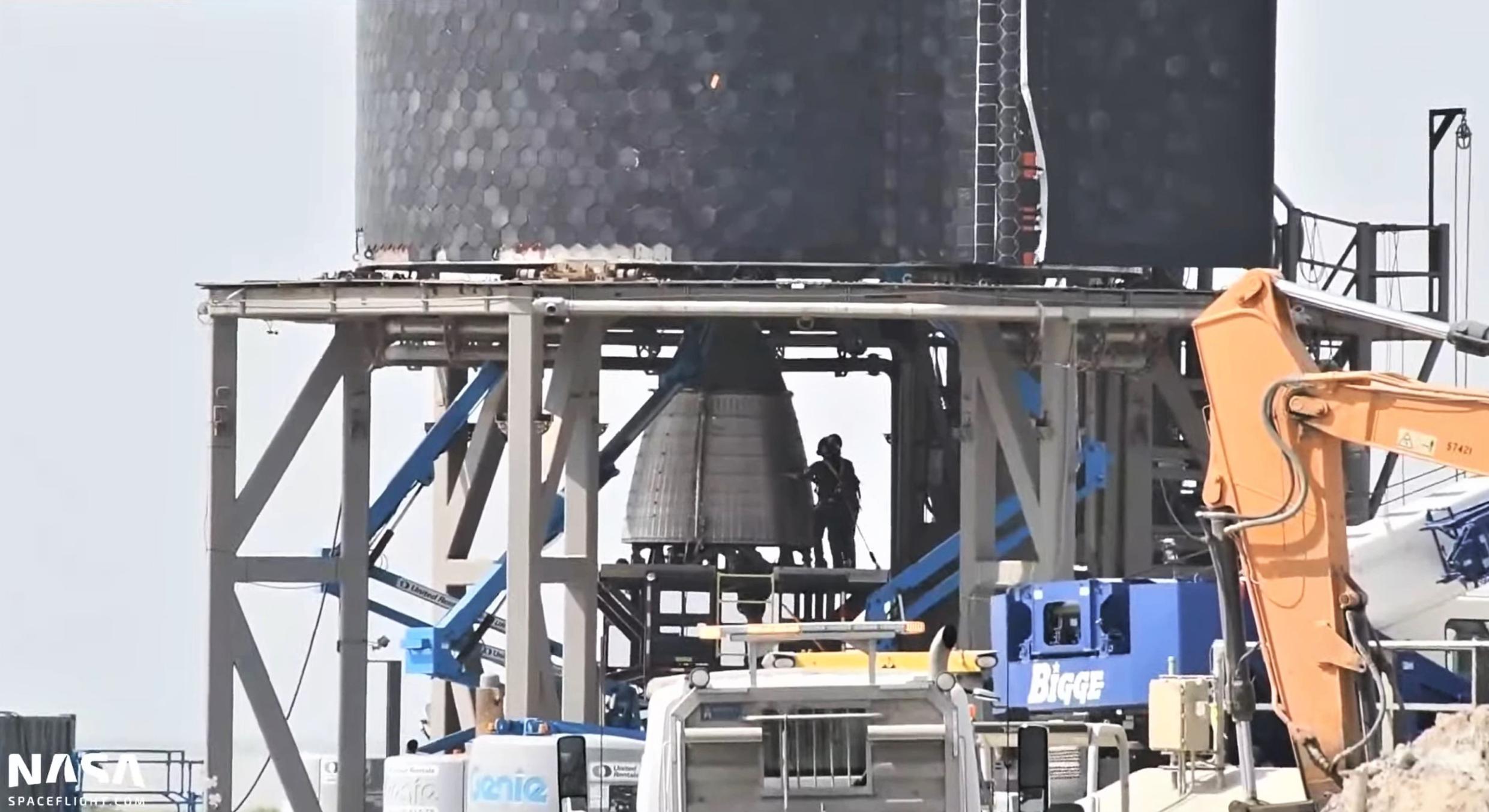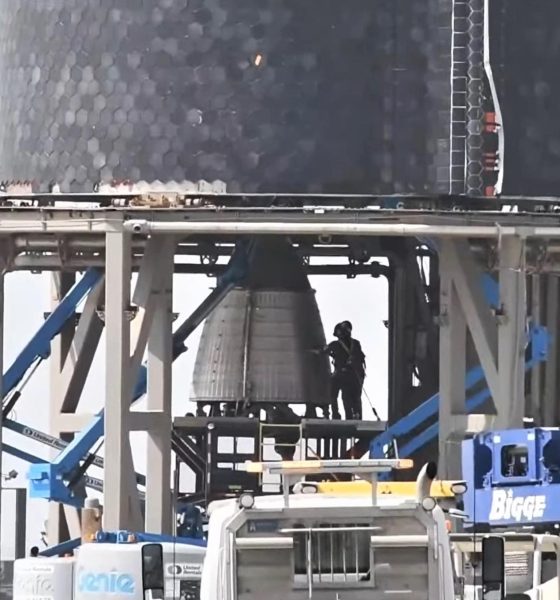

News
SpaceX installs Raptor Vacuum engine on first orbital-class Starship
Update: Providing the best views yet of the Raptor Vacuum installation process, SpaceX began installing one of Starship S20’s six engines (one of at least two recently trucked to the launch site) on Monday morning.
It remains to be seen exactly how many engines will be installed on Ship 20 or how many will be ignited during its first static fire test but barring the delivery of more Raptors, signs currently point to an initial test of two engines – one sea-level-optimized Raptor Center (RC) and one Raptor Vacuum with a much larger nozzle. Whenever Ship 20 does fire up those engines, it will be the first static fire of a RVac engine installed on a Starship and the first simultaneous, side-by-side static fire of two different Raptor variants. Since publishing time, SpaceX has cancelled a Tuesday road closure, pushing Starship S20’s first static fire attempt to no earlier than (NET) Wednesday evening.
For the third time in two months, SpaceX has begun installing Raptor engines on its first orbital-class Starship prototype – hopefully for good.
In no uncertain terms, Starship 20’s (S20) path to what could be its last Raptor installations has been about as windy and mysterious as they come. Starship 20 (S20) left the Starbase factory floor for the first time in early August – all six Raptors installed in another program first – for a brief fit check and photo op. After spending about an hour installed on top of Super Heavy Booster 4 (B4), Ship 20 was removed and returned to the build site, where teams removed all six engines and finished wiring and plumbing the vehicle.
Days before the ship’s long-anticipated trip to Starbase’s suborbital launch site for qualification testing, the mount SpaceX prepared for the process quickly had hydraulic rams – used to safely simulate Raptor thrust – were abruptly removed. Starship S20 was then installed on the Pad B mount, where SpaceX proceeded to reinstall six Raptors. Weeks later, after slow heat shield repairs neared completion, SpaceX again removed Ship 20’s Raptors and reinstalled the hydraulic rams it had removed – unused – the month prior. Finally, on September 30th, some seven weeks after the prototype arrived at the suborbital launch site, SpaceX put Starship S20 through its first major test – a lengthy ‘cryoproof’.
Now, ten days after completing a seemingly flawless cryoproof test on its first try, SpaceX has once again trucked multiple Raptors – at least one sea level and one vacuum engine – from the Starbase build site to Starship S20’s suborbital test stand. From the outside looking in, it’s hard not to view the contradictory path S20 took to its first tests – and is still taking to its first static fire(s) – as an unusually visible sign of some kind of internal tug of war or major communication failure between different SpaceX groups or executives.
It’s impossible to determine anything specific beyond the apparent fact that several of the steps taken from Ship 20’s first factory departure to its first cryoproof and static fire tests could have probably been deleted entirely with no harm done and many dozens of hours of work saved. At the end of the day, Starship S20 completed cryoproof testing without issue on the first try and is now seemingly on track to begin its first static fire test campaign later this month.
At the moment, SpaceX has three possible static fire test windows scheduled from 5pm to midnight CDT on Tuesday, Wednesday, and Thursday (Oct 12-14). A similar Monday window was canceled days ago on October 7th, suggesting that more cancellations are probably on the horizon. For now, there’s a chance that Starship S20 – with anywhere from two to all six Raptor engines installed – will fire up for the first time before next weekend. It’s hard to say how exactly SpaceX will proceed. It’s not inconceivable that SpaceX will install all six engines and gradually ramp up to a full six-engine static fire over several tests.

Given that SpaceX has already static fired three Raptor Center (RC) engines on multiple Starship and Super Heavy prototypes, odds are good that Starship S20’s test campaign will be similar – beginning with a three-Raptor static fire, in other words. SpaceX could then add one, two, or all three Raptor Vacuum engines into the fray for one or more additional tests with 4-6 engines total. It’s also possible that suborbital launch mount and pad limitations will prevent more than three engines from firing at once, in which case SpaceX would presumably perform two separate tests of Ship 20’s Raptor Center and Raptor Vacuum engines.
Given that two Raptor variants have never been static fired simultaneously on the same vehicle, it’s hard to imagine that SpaceX won’t also want to perform one or several combined static fires with Raptor Vacuum and Raptor Center engines on Ship 20.

News
Tesla Giga Berlin draws “red line” over IG Metall union’s 35-hour week demands
Factory manager André Thierig has drawn a “red line” against reducing Giga Berlin’s workweek to 35 hours, while highlighting that Tesla has actually increased its workers’ salaries more substantially than other carmakers in the country.

Tesla Giga Berlin has found itself in a new labor dispute in Germany, where union IG Metall is pushing for adoption of a collective agreement to boost wages and implement changes, such as a 35-hour workweek.
In a comment, Giga Berlin manager André Thierig drew a “red line” against reducing Giga Berlin’s workweek to 35 hours, while highlighting that Tesla has actually increased its workers’ salaries more substantially than other carmakers in the country.
Tesla factory manager’s “red line”
Tesla Germany is expected to hold a works council election in 2026, which André Thierig considers very important. As per the Giga Berlin plant manager, Giga Berlin’s plant expansion plans might be put on hold if the election favors the union. He also spoke against some of the changes that IG Metall is seeking to implement in the factory, like a 35-hour week, as noted in an rbb24 report.
“The discussion about a 35-hour week is a red line for me. We will not cross it,” Theirig said.
“(The election) will determine whether we can continue our successful path in the future in an independent, flexible, and unbureaucratic manner. Personally, I cannot imagine that the decision-makers in the USA will continue to push ahead with the factory expansion if the election results favor IG Metall.”
Giga Berlin’s wage increase
IG Metall district manager Jan Otto told the German news agency DPA that without a collective agreement, Tesla’s wages remain significantly below levels at other German car factories. He noted the company excuses this by referencing its lowest pay grade, but added: “The two lowest pay grades are not even used in car factories.”
In response, Tesla noted that it has raised the wages of Gigafactory Berlin’s workers more than their German competitors. Thierig noted that with a collective agreement, Giga Berlin’s workers would have seen a 2% wage increase this year. But thanks to Tesla not being unionized, Gigafactory Berlin workers were able to receive a 4% increase, as noted in a CarUp report.
“There was a wage increase of 2% this year in the current collective agreement. Because we are in a different economic situation than the industry as a whole, we were able to double the wages – by 4%. Since production started, this corresponds to a wage increase of more than 25% in less than four years,” Thierig stated.
News
Tesla is seeing a lot of momentum from young Koreans in their 20s-30s: report
From January to November, young buyers purchased over 21,000 Teslas, putting it far ahead of fellow imported rivals like BMW and Mercedes-Benz.

Tesla has captured the hearts of South Korea’s 20s-30s demographic, emerging as the group’s top-selling imported car brand in 2025. From January to November, young buyers purchased over 21,000 Teslas, putting it far ahead of fellow imported rivals like BMW and Mercedes-Benz.
Industry experts cited by The Economist attributed this “Tesla frenzy” to fandom culture, where buyers prioritize the brand over traditional car attributes, similar to snapping up the latest iPhone.
Model Y dominates among young buyers
Data from the Korea Imported Automobile Association showed that Tesla sold 21,757 vehicles to the 20s-30s demographic through November, compared to BMW’s 13,666 and Mercedes-Benz’s 6,983. The Model Y led the list overwhelmingly, with variants like the standard and Long Range models topping purchases for both young men and women.
Young men bought around 16,000 Teslas, mostly Model Y (over 15,000 units), followed by Model 3. Young women followed a similar pattern, favoring Model Y (3,888 units) and Model 3 (1,083 units). The Cybertruck saw minimal sales in this group.
The Model Y’s appeal lies in its family-friendly SUV design, 400-500 km range, quick acceleration, and spacious cargo, which is ideal for commuting and leisure. The Model 3, on the other hand, serves as an accessible entry point with lower pricing, which is valuable considering the country’s EV subsidies.
The Tesla boom
Experts described Tesla’s popularity as “fandom culture,” where young buyers embrace the brand despite criticisms from skeptics. Professor Lee Ho-geun called Tesla a “typical early adopter brand,” comparing purchases to iPhones.
Professor Kim Pil-soo noted that young people view Tesla more as a gadget than a car, and they are likely drawn by marketing, subsidies, and perceived value. They also tend to overlook news of numerous recalls, which are mostly over-the-air software updates, and controversies tied to the company.
Tesla’s position as Korea’s top import for 2025 seems secured. As noted by the publication, Tesla’s December sales figures have not been reported yet, but market analysts have suggested that Tesla has all but secured the top spot among the country’s imported cars this year.
News
Tesla FSD fleet is nearing 7 billion total miles, including 2.5 billion city miles
As can be seen on Tesla’s official FSD webpage, vehicles equipped with the system have now navigated over 6.99 billion miles.

Tesla’s Full Self-Driving (Supervised) fleet is closing in on almost 7 billion total miles driven, as per data posted by the company on its official FSD webpage.
These figures hint at the massive scale of data fueling Tesla’s rapid FSD improvements, which have been quite notable as of late.
FSD mileage milestones
As can be seen on Tesla’s official FSD webpage, vehicles equipped with the system have now navigated over 6.99 billion miles. Tesla owner and avid FSD tester Whole Mars Catalog also shared a screenshot indicating that from the nearly 7 billion miles traveled by the FSD fleet, more than 2.5 billion miles were driven inside cities.
City miles are particularly valuable for complex urban scenarios like unprotected turns, pedestrian interactions, and traffic lights. This is also the difference-maker for FSD, as only complex solutions, such as Waymo’s self-driving taxis, operate similarly on inner-city streets. And even then, incidents such as the San Francisco blackouts have proven challenging for sensor-rich vehicles like Waymos.
Tesla’s data edge
Tesla has a number of advantages in the autonomous vehicle sector, one of which is the size of its fleet and the number of vehicles training FSD on real-world roads. Tesla’s nearly 7 billion FSD miles then allow the company to roll out updates that make its vehicles behave like they are being driven by experienced drivers, even if they are operating on their own.
So notable are Tesla’s improvements to FSD that NVIDIA Director of Robotics Jim Fan, after experiencing FSD v14, noted that the system is the first AI that passes what he described as a “Physical Turing Test.”
“Despite knowing exactly how robot learning works, I still find it magical watching the steering wheel turn by itself. First it feels surreal, next it becomes routine. Then, like the smartphone, taking it away actively hurts. This is how humanity gets rewired and glued to god-like technologies,” Fan wrote in a post on X.








